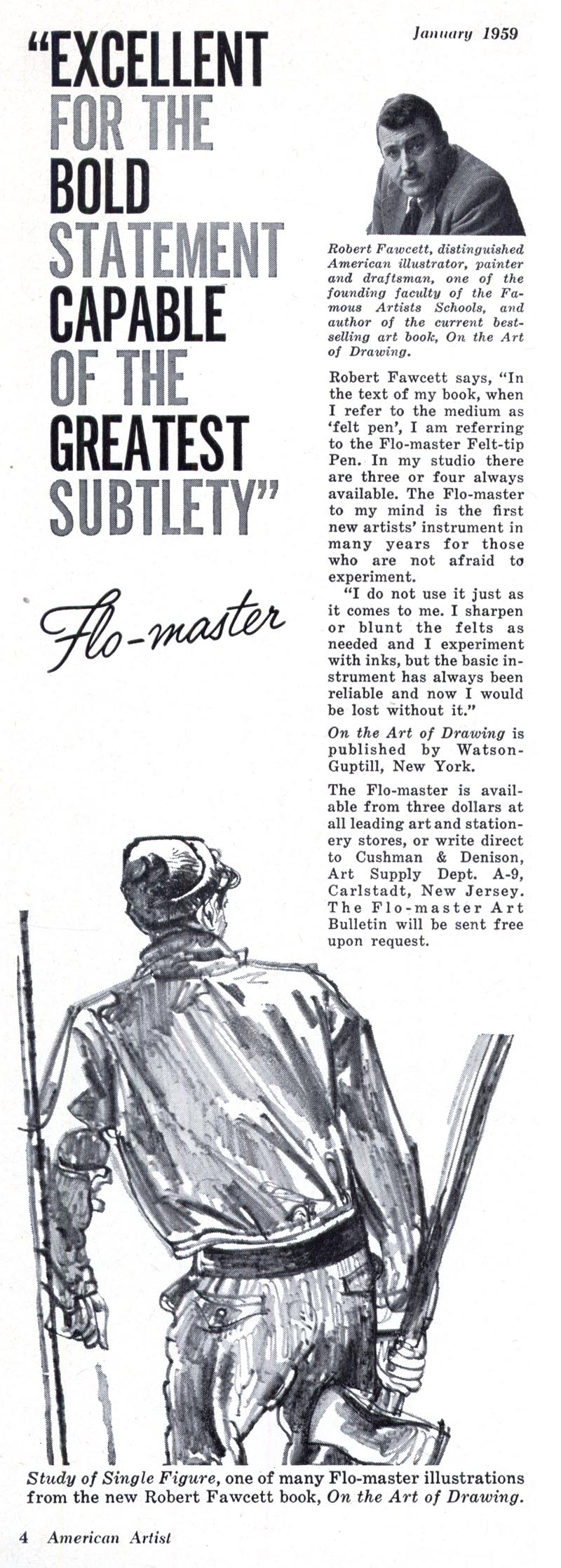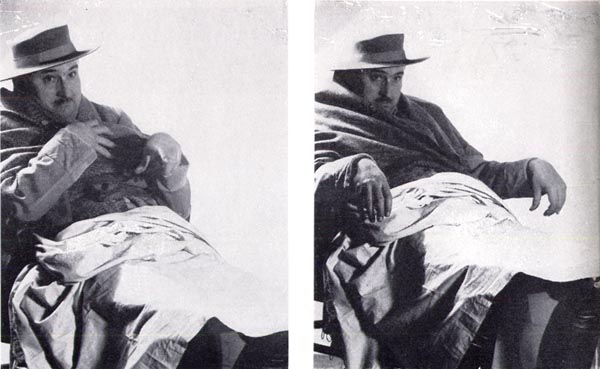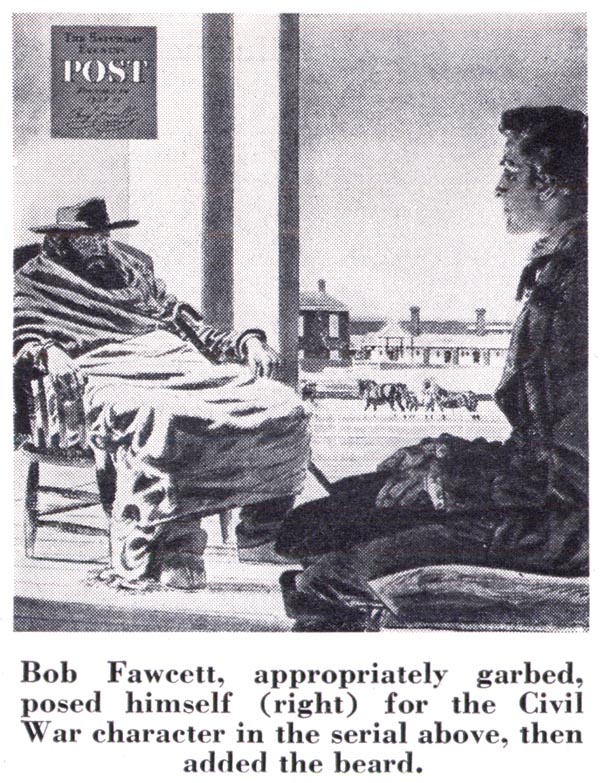"...a short discussion on the value of photography is pertinent here. As an illustrator I am all too conscious of the way photography has been abused, to the point where many illustrators are afraid to put pencil to paper without first photographing their subject exhaustively. Too often, as a result, they allow photography to use them, instead of them using it, in the way they might use any other studio materials."

"I have observed that illustration is more akin to the theatre than to painting and the value of lighting for dramatic effect in both the theatre and illustration cannot be overestimated. Photography can capture this in a way nothing else can equal. Imagine, if you will, a model sitting for hours under the hot lights necessary for a particular dramatic situation, perspiring and uncomfortable (and incidentally running up a bill for fees perhaps out of proportion to the job in hand)."

"In regard to models, the artist in industry is in competition with the photographer in more than one sense. Model fees are high, but the photographer can get his results in an hour. Economically, photography as an aid to the illustrator is necessary if only to allow him to compete on more or less equal terms."

"I would like to have avoided this discussion of photography in a book devoted to the purer aspects of drawing. But it would have been artificial to ignore it, especially since even many painters employ photography these days. Another of the best French painters of our times did not even trouble to take his own pictures, but painted largely from post cards bought at the local shop. And this was a fine painter, whose pictures, although they might be characterized as post-cardy in subject and concept, were never photographic. He used them simply as a point of departure."

"So much, I think, for photography. There is no contradiction here with anything we have discussed up to this time. We talk about it now simply because this chapter on illustration is about an applied art form, graphic art for industry. This is an entirely different subject, with its own conditions, its own taboos, its own peculiar problems. Most European schools devoted to fine arts shun this subject, while many American schools include elaborate courses on it. The European idea is, I think, commendable but unrealistic."

"The American way is typical of a society which places too little value on abstract learning, and which puts too great an emphasis on practicality."

"One who illustrates should give it his best. His stature as an artist is beyond his control, so he will be better for not pondering too much about it."
"But the technique of his craft is not only under his control, it is also possible of development, so the wise worker will concentrate upon it. If he fails to reach out and develop as an artist, if he remains a technician that, of course, is sad, except that I cannot feel that he would have been a better artist with less craft."
"Draftsmanship, or good drawing, will always be the basis of the artist's craft."
* My Robert Fawcett Flickr set.
* Thanks to Tom Watson and Brian Postman for contributing scans to today's post!
Fawcett was the only person on the planet who could get those Flo-Master pens (a primitive precursor to the magic marker) to work that way. He would let the nibs partially dry out for a rough line, or crush the nib for a broad line, and get wonderful results. The flo-master company was so delighted with the publicity that they gave Fawcett a lifetime supply. But other artists who tried to duplicate Fawcett's results were always disappointed.
ReplyDeleteUnfortuately, the chemicals weren't meant to last, and most of those beautiful drawings have faded away.
Something kind of poetic in that, I think.
ReplyDeleteI wanna give you a kiss for this post leif. Thank you!
ReplyDeleteWell, heck, you're welcome, anonymous. ;^)
ReplyDeleteive been a recent blurker on this site but i will be good and let you know how much i appreciate all your informative posts and for the beautiful scans, thank you!
ReplyDeleteAnother wonderful post, thank you! That's the best advice there is, unfortunately it's hardly encouraged (if not discouraged) these days.
ReplyDeleteLike elena-lu said, these great posts and scans are very much appreciated!
Thanks elena-lu and Bec for piping up! The point I hope readers of this week's posts take away with themis that Fawcett, 'the illustrator's illustrator', wrote these words 50 years ago. Remarkable that he was speaking to a generation we look back upon as having an inordinate amount of classical training (and thinking) bestowed upon them. Yet Fawcett's words ring truer today than ever before.
ReplyDeleteI'm not casting aspersions on any of my peers... I'm thinking of myself ( and I've been at this for twenty years! ) ... but I can't help but wonder how many illustrators who read this week's post had to pause and consider their own shortcomings, as I did.
That's why I began this week's series by writing that Fawcett's book is my new bible. The pictures are wonderful ... but its his words that truly inspire!
Thanks for another great week Leif.Fawcett was the product of an incredibly rigorous training at the Slade in London when it was at its best,I would argue that any of us would have a hard time reaching his level of skill in this day and age.
ReplyDeleteA terrific week of posts, with some great Fawcetts I hadn't seen before. Hate to see the week end.
ReplyDelete--Bob Cosgrove
I agree, anonymous, reading about those two years of day after day pencil drawing makes me think of those kung fu masters during their early days of training with the monks at the monastery! But I take heart at Fawcett's remark: "One who illustrates should give it his best. His stature as an artist is beyond his control, so he will be better for not pondering too much about it."
ReplyDeleteBob; the good news is word came this week that a Fwcett book is to be released later this year from Manuel Auad.
Great pictures.
ReplyDeleteHow I adore the last one - this pensive figure amidst all those still lives.
Haven't seen it before! Why are all the David Hoppers so well known and not this one?
Who are the French artists that he refers too?
ReplyDeleteI always found it a shame that illustrators today rarely hire models or work from life. Generally it's either out of their head or created from a photo found on google.
I understand that the market is different today and I guess I'm a bit nostalgic for the past in saying all this. But having the option to hire a model is something I wish was still there for illustrators today.
In the end I think the most important thing is doing the best work possible. Being out of your head, from life, from a photo....whatever. It doesn't really matter just as long as the work is the best it can be.
You know it just hit me that Fawcett looks the image of that British actor Alfred Molina.Kind of trivial I know.Sorry.
ReplyDeleteThat's ok, anonymous - I welcome your comments - trivial or otherwise! ;^)
ReplyDelete